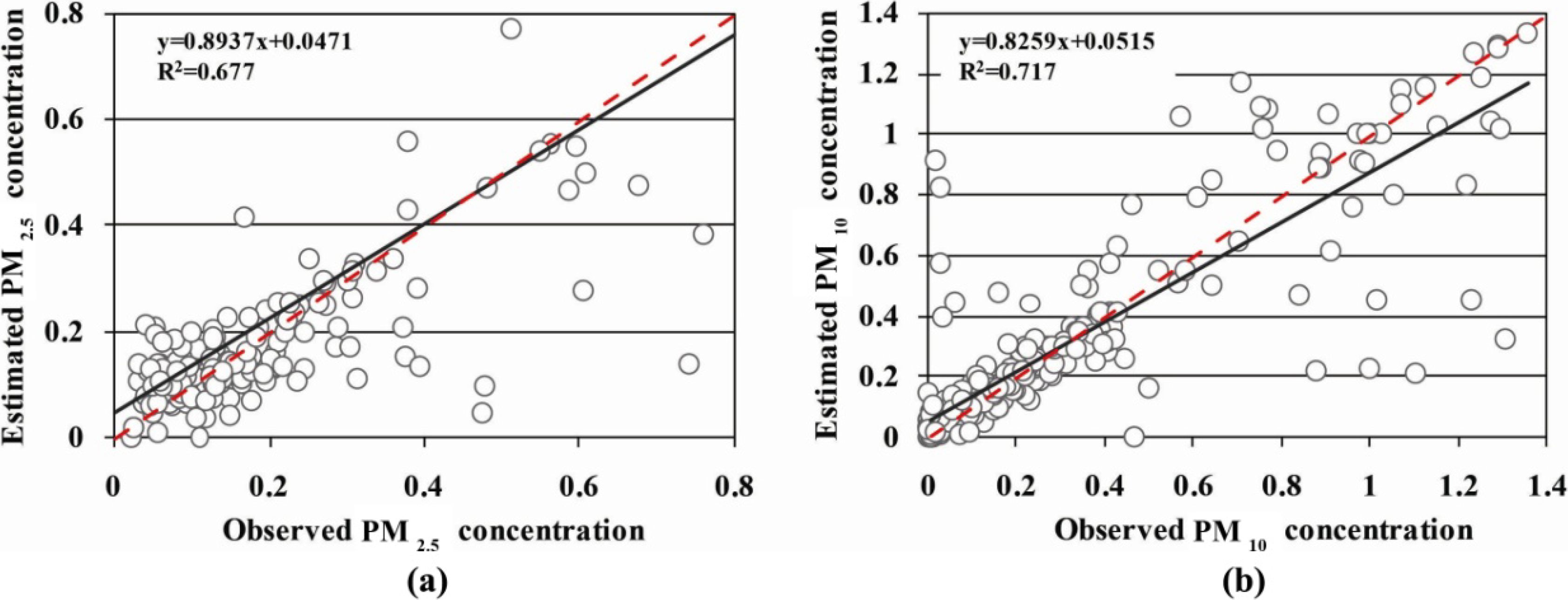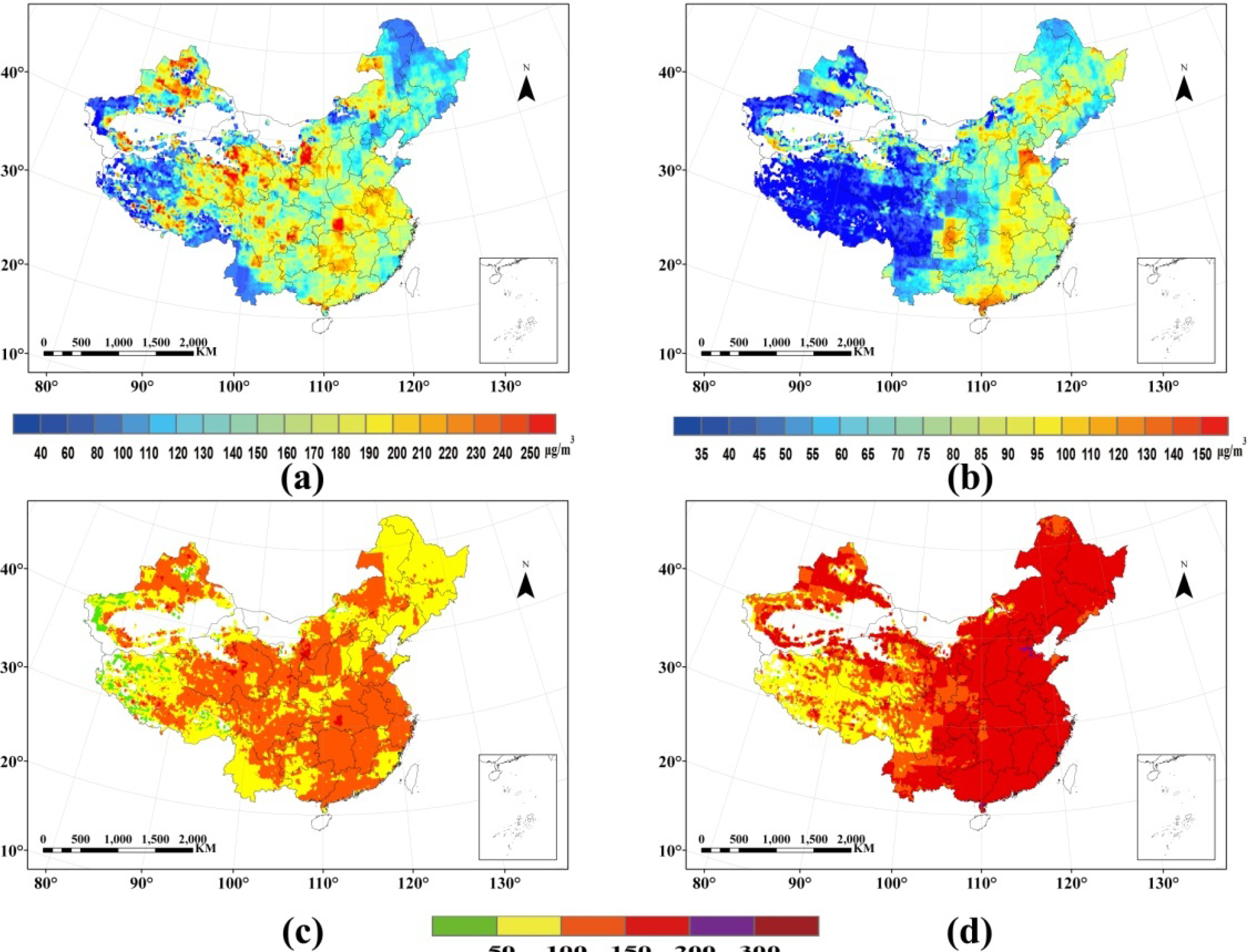Particulate Matter Pollution and Population Exposure Assessment over Mainland China in 2010 with Remote Sensing
Abstract
:1. Introduction
2. Materials and Methods
2.1. Study Area and Data Sources
- (1)
- (2)
- Meteorological data (ERA-Interim), the latest global atmospheric reanalysis data produced by the European Centre for Medium-Range Weather Forecasts (ECMWF). Dee et al. [18] have covered the details of the ERA-Interim product.
- (3)
- Population density gridded data derived from the Center for International Earth Science Information Network (CIESIN) contains the human population distribution. It is a gridded data product that renders global population data at the scale and extent required to demonstrate the spatial relationship of human population and the environment across the globe.
2.2. PM10 and PM2.5 Concentration Estimation

2.3. PAQI Calculation



2.4. Per Capita and Population-Weighted PM2.5 Concentration Calculation


3. Results and Discussion
3.1. Spatial Distribution of PM Pollution




3.2. Population Exposure Assessment

4. Conclusions
Acknowledgments
Author Contributions
Conflicts of Interest
References
- Li, H.; Zeng, F.G.; Shao, L.Y. Current status of study on the human health effects of inhalable particulates. J. Environ. Health 2002, 19, 85–87. [Google Scholar]
- Hu, H.; Dailey, A.B.; Kan, H.; Xu, X. The effect of atmospheric particulate matter on survival of breast cancer among USA females. Breast Cancer Res. Treat. 2013, 139, 217–226. [Google Scholar] [CrossRef]
- Pope, C.A., III; Dockery, D.W. Epidemiology of particle effects. Air Pollut. Health 1999, 31, 673–705. [Google Scholar] [CrossRef]
- Zhang, A.; Qi, Q.; Jiang, L.; Zhou, F.; Wang, J. Population exposure to PM2.5 in the urban area of Beijing. PLoS One 2013, 8. [Google Scholar] [CrossRef]
- Avasn, M.Y.; Kaizar, H.; Priya, B.P.; Neelakanta, R.L. Dust pollution: A case study in old town area, Visakhapatnam. Res. J. Chem. Environ. 2009, 13, 96–98. [Google Scholar]
- Lin, G.; Fu, J.; Jiang, D.; Hu, W.; Dong, D.; Huang, Y.; Zhao, M. Spatio-temporal variation of PM2.5 concentrations and their relationship with geographic and socioeconomic factors in China. Int. J. Environ. Res. Public Health 2013, 11, 173–186. [Google Scholar] [CrossRef]
- Cheng, W.L.; Chen, Y.S.; Zhang, J.; Lyons, T.J.; Pai, J.L.; Chang, S.H. Comparison of the revised air quality index with the PSI and AQI indices. Sci. Total Environ. 2007, 382, 191–198. [Google Scholar] [CrossRef]
- Sowlat, M.H.; Gharibi, H.; Yunesian, M.; Maryam, T.M.; Lotfi, S. A novel, fuzzy-based air quality index (FAQI) for air quality assessment. Atmos. Environ. 2011, 45, 2050–2059. [Google Scholar] [CrossRef]
- Gupta, P.; Christopher, S.A. Particulate matter air quality assessment using integrated surface, satellite, and meteorological products: 2. A neural network approach. J. Geophys. Res. 2009, 10. [Google Scholar] [CrossRef]
- Zhang, M.S.; Song, Y.; Cai, X.H. A health-based assessment of particulate air pollution in urban areas of Beijing in 2000–2004. Sci. Total Environ. 2007, 376, 100–108. [Google Scholar] [CrossRef]
- Xu, X.; Dockery, D.W.; Christiani, D.C.; Li, B.; Huang, H. Association of air pollution with hospital outpatient visits in Beijing. Arch. Environ. Health 1995, 50, 214–220. [Google Scholar] [CrossRef]
- Kan, H.D.; Chen, B.H. A case-crossover analysis of air pollution and daily mortality in Shanghai. J. Occup. Health 2003, 45, 119–124. [Google Scholar] [CrossRef]
- Qian, Z.; He, Q.; Lin, H.M.; Kong, L.; Liao, D.; Dan, J.; Bentley, C.M.; Wang, B. Association of daily cause-specific mortality with ambient particle air pollution in Wuhan, China. Environ. Res. 2007, 105, 380–389. [Google Scholar] [CrossRef]
- Sun, Z.B.; An, X.Q.; Tao, Y.; Hou, Q. Assessment of population exposure to PM10 for respiratory disease in Lanzhou (China) and its health-related economic costs based on GIS. BMC Public Health 2013, 13. [Google Scholar] [CrossRef]
- Wong, T.W.; Lau, T.S.; Yu, T.S.; Neller, A.; Wong, S.L.; Tam, W.; Pang, S.W. Air pollution and hospital admissions for respiratory and cardiovascular diseases in Hong Kong. Occup. Environ. Med. 1999, 56, 679–683. [Google Scholar] [CrossRef]
- Remer, L.A.; Kaufman, Y.J.; Tanre, D.; Mattoo, S.; Chu, D.A.; Martins, J.V.; Li, R.R.; Ichoku, C.; Levy, R.C.; Kleidman, R.G.; Eck, T.F.; Vermote, E.; Holben, B.N. The MODIS aerosol algorithm, products, and validation. J. Atmos. Sci. 2005, 62, 947–973. [Google Scholar] [CrossRef]
- Levy, R.C.; Remer, L.A.; Mattoo, S.; Vermote, E.F.; Kaufman, Y.J. Second-generation operational algorithm: Retrieval of aerosol properties over land from inversion of Moderate Resolution Imaging Spectroradiometer spectral reflectance. J. Geophys. Res. 2007, 112. [Google Scholar] [CrossRef]
- Dee, D.P.; Uppala, S.M.; Simmons, A.J.; Berrisford, P.; Poli, P.; Kobayashi, S. The ERA-interim reanalysis: Configuration and performance of the data assimilation system. Quart. J. Roy. Meteorol. Soc. 2011, 137, 553–597. [Google Scholar] [CrossRef]
- Gupta, P.; Christopher, S.A. Particulate matter air quality assessment using integrated surface, satellite, and meteorological products: Multiple regression approach. J. Geophys. Res. 2009, 7. [Google Scholar] [CrossRef]
- Yao, L.; Lu, N.; Jiang, S. Artificial Neural Network (ANN) for Multi-source PM2.5 Estimation using Surface, MODIS, and Meteorological Data. In Proceedings of International Conference of Biomedical Engineering and Biotechnology (ICBEB), Macau, China, 28 May 2012; pp. 1228–1231.
- Blackwell, W.J.; Chen, F.W.B. Neural Networks in Atmospheric Remote Sensing, 1st ed.; Artech House: Boston, MA, USA, 2009; pp. 100–104. [Google Scholar]
- People’s Republic of China Ministry of Environmental Protection Standard: Technical Regulation on Ambient Air Quality Index. (in Chinese). Available online: http://kjs.mep.gov.cn/hjbhbz/bzwb/dqhjbh/jcgfffbz/201203/W020120410332725219541.pdf (accessed on 9 May 2014).
- Pu, Y.J.; Wang, L.B. Discussion on comprehensive index assessment method of environmental air quality. (in Chinese). Environ Sci. Surv. 2010, 29, 93–94. [Google Scholar]
- Bishoi, B.; Prakash, A.; Jain, V.K. A comparative study of air quality index based on factor analysis and USA—EPA methods for an urban environment. Aerosol Air Qual. Res. 2009, 9, 1–17. [Google Scholar]
© 2014 by the authors; licensee MDPI, Basel, Switzerland. This article is an open access article distributed under the terms and conditions of the Creative Commons Attribution license (http://creativecommons.org/licenses/by/3.0/).
Share and Cite
Yao, L.; Lu, N. Particulate Matter Pollution and Population Exposure Assessment over Mainland China in 2010 with Remote Sensing. Int. J. Environ. Res. Public Health 2014, 11, 5241-5250. https://doi.org/10.3390/ijerph110505241
Yao L, Lu N. Particulate Matter Pollution and Population Exposure Assessment over Mainland China in 2010 with Remote Sensing. International Journal of Environmental Research and Public Health. 2014; 11(5):5241-5250. https://doi.org/10.3390/ijerph110505241
Chicago/Turabian StyleYao, Ling, and Ning Lu. 2014. "Particulate Matter Pollution and Population Exposure Assessment over Mainland China in 2010 with Remote Sensing" International Journal of Environmental Research and Public Health 11, no. 5: 5241-5250. https://doi.org/10.3390/ijerph110505241




